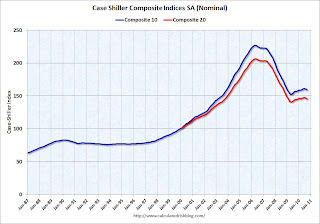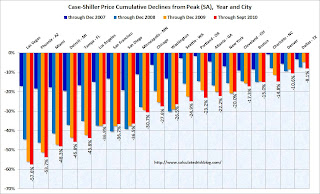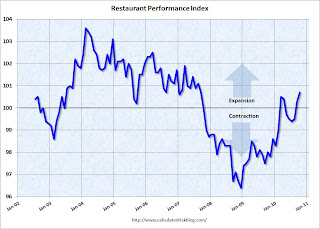by Calculated Risk on 11/30/2010 04:16:00 PM
Tuesday, November 30, 2010
Europe Update and more
On Europe:
• From the WSJ: Fresh Round of 'Stress Tests' Planned for European Banks
The [first stress] tests were largely discredited by revelations that they lacked rigor, including a Wall Street Journal report in September that the tests understated some banks' holdings of potentially risky sovereign bonds. ... "There was some variety in terms of rigor and application of [the initial] tests," European Economic and Monetary Affairs Commissioner Olli Rehn said in Brussels.Oh yeah. Ireland's banks passed the initial stress tests in July! And we know how that worked out.
• From the Financial Times: Trichet hints at more bond purchases. The Financial Times quotes European Central Bank president Jean-Claude Trichet as saying “pundits are under-estimating the determination of governments” and “I don’t think that financial stability in the eurozone, given what I know, could really be called into question.”
• From Bloomberg: Italy-Germany 10-Year Yield Spread Reaches 200 Points, Widest Since 1997. That is just a sample of the headlines on European bonds. And everyone is trying to figure out how to add "B" to PIIGS.
And on a more positive note ...
• The Chicago PMI for November (released this morning) was stronger than expected. Production (at 62.5) "reached its highest level since February 2005", and new orders (67.2) increased "to a level not seen since 2007. The employment index increased to 56.3 from 54.6 in October. This continues the trend of stronger reports recently. I'll have an employment preview on Thursday, and I'll probably take the over again this month (consensus is 145,000 non-farm payroll jobs).
Rumor: WikiLeaks to release BofA documents?
by Calculated Risk on 11/30/2010 02:23:00 PM
From Andy Greenberg at Forbes yesterday: WikiLeaks’ Julian Assange Wants To Spill Your Corporate Secrets (ht Robert)
Early next year, Julian Assange says, a major American bank will suddenly find itself turned inside out. Tens of thousands of its internal documents will be exposed on Wikileaks.org ... The data dump will lay bare the finance firm’s secrets on the Web for every customer, every competitor, every regulator to examine and pass judgment on.And from Andy Greenberg today: Is Bank Of America WikiLeaks’ Next Target?
[A]n eagle-eyed reader has sent me a link to a quote from a Computer World interview with Assange from October of 2009, which, if true, may contain a clue to that bank’s identity:“At the moment, for example, we are sitting on five gigabytes from Bank of America, one of the executive’s hard drives,” he said. “Now how do we present that? It’s a difficult problem. We could just dump it all into one giant Zip file, but we know for a fact that has limited impact. To have impact, it needs to be easy for people to dive in and search it and get something out of it.”
Real House Prices, Q3 2010
by Calculated Risk on 11/30/2010 12:04:00 PM
This morning, S&P reported that there were "broad based" house price declines in Q3. And earlier this month, CoreLogic reported that house prices declined 1.8% in September.
The following graph shows the Case-Shiller National index (quarterly), the Case-Shiller Composite 20 index, and the CoreLogic House Price Index in real terms (adjusted for inflation using CPI less shelter).
 Click on graph for larger image in new window.
Click on graph for larger image in new window.
In real terms, all three indexes are back to 2000 / 2001 prices. The real Case-Shiller national index is at a new cycle low, and the real Case-Shiller Composite 20 and real CoreLogic indexes are just above the cycle low (and will be at new lows soon).
A few key points:
• In many areas - if the population is increasing - house prices increase slightly faster than inflation over time, so there is an upward slope in real prices.
• Even if real prices are still too high, they are much closer to the eventual bottom than the top in 2005. This isn't like in 2005 when prices were way out of the normal range.
• With high levels of inventory, prices will probably fall some more. (My forecast earlier this year was for 5% to 10% additional price declines on the repeat sales indexes).
Case-Shiller: Broad-based Declines in Home Prices in Q3
by Calculated Risk on 11/30/2010 09:00:00 AM
S&P/Case-Shiller released the monthly Home Price Indices for September (actually a 3 month average of July, August and September).
This includes prices for 20 individual cities, and two composite indices (10 cities and 20 cities), and the quarterly national index.
Note: Case-Shiller reports NSA, I use the SA data.
From S&P: Broad-based Declines in Home Prices in the 3rd Quarter of 2010
Data through September 2010, released today by Standard & Poor’s for its S&P/Case-Shiller Home Price Indices ... show that the U.S. National Home Price Index declined 2.0% in the third quarter of 2010, after having risen 4.7% in the second quarter. Nationally, home prices are 1.5% below their year-earlier levels. In September, 18 of the 20 MSAs covered by S&P/Case-Shiller Home Price Indices and both monthly composites were down; and only the two composites and five MSAs showed year-over-year gains. While housing prices are still above their spring 2009 lows, the end of the tax incentives and still active foreclosures appear to be weighing down the market.
 Click on graph for larger image in new window.
Click on graph for larger image in new window. The first graph shows the nominal seasonally adjusted Composite 10 and Composite 20 indices (the Composite 20 was started in January 2000).
The Composite 10 index is off 29.8% from the peak, and down 0.7% in September(SA).
The Composite 20 index is off 29.6% from the peak, and down 0.8% in September (SA).
 The second graph shows the Year over year change in both indices.
The second graph shows the Year over year change in both indices.The Composite 10 is up 1.5% compared to September 2009.
The Composite 20 is up 0.5% compared to September 2009.
Case-Shiller reported that nationally home prices are 1.5% below their year-earlier levels. The year-over-year increases in the composite indexes are slowing, and will probably be negative later this year.
The third graph shows the price declines from the peak for each city included in S&P/Case-Shiller indices.
 Prices increased (SA) in only 1 of the 20 Case-Shiller cities in September seasonally adjusted. Only Wash, D.C. saw a price increase (SA) in September, and that was very small.
Prices increased (SA) in only 1 of the 20 Case-Shiller cities in September seasonally adjusted. Only Wash, D.C. saw a price increase (SA) in September, and that was very small. Prices in Las Vegas are off 57.6% from the peak, and prices in Dallas only off 8.1% from the peak.
Prices are now falling - and falling just about everywhere. And it appears there are more price declines coming (based on inventory levels and anecdotal reports).
Monday, November 29, 2010
Restaurant Performance Index highest in three years
by Calculated Risk on 11/29/2010 10:45:00 PM
This is one of several industry specific indexes I track each month.
 Click on graph for larger image in new window.
Click on graph for larger image in new window.
Unfortunately the data for this index only goes back to 2002.
Note: Any reading above 100 shows expansion for this index.
From the National Restaurant Association (NRA): Restaurant Performance Index highest in three years
"The National Restaurant Association’s Restaurant Performance Index in October reached 100.7. This is the highest level for the index in over three years, since September 2007, and reflects a strengthening environment of consumer spending at restaurants." said Hudson Riehle, senior vice president of the Research and Knowledge Group for the National Restaurant Association.
Restraurants are a discretionary expense, and this expansion suggests consumers are becoming more confident.
DOT: Vehicle miles driven increased in September
by Calculated Risk on 11/29/2010 05:49:00 PM
The Department of Transportation (DOT) reported that vehicle miles driven in September were up 1.5% compared to September 2009:
Travel on all roads and streets changed by +1.5% (3.7 billion vehicle miles) for September 2010 as compared with September 2009.
Cumulative Travel for 2010 changed by +0.5% (11.1 billion vehicle miles).
 Click on graph for larger image in new window.
Click on graph for larger image in new window.This graph shows the rolling 12 month total vehicle miles driven.
On a rolling 12 month basis, vehicle miles driven have only increased slightly from the bottom of the recession.
Miles driven are still 1.6% below the peak in 2007. This is another indicator of a sluggish recovery. And this report was for September when oil prices were in the mid $70s per barrel. Oil prices moved up to the mid $80s today, and that might impact miles driven in December.


